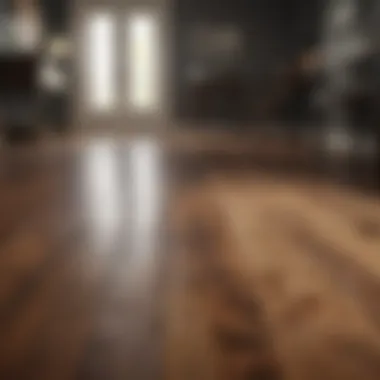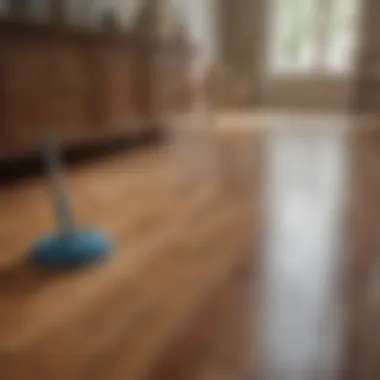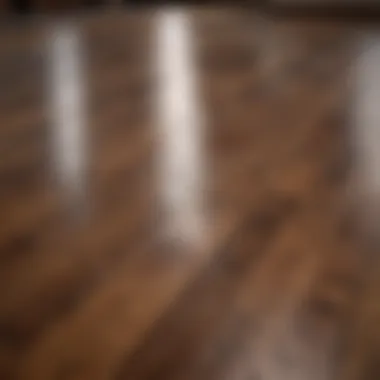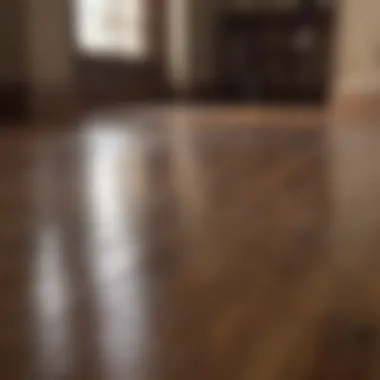Comprehensive Guide to Cleaning Old Hardwood Floors


Intro
Hardwood floors possess a timeless beauty. However, over time, these surfaces can become dirty and worn. Regular maintenance is crucial to preserve their charm and longevity. This guide will present a detailed overview of how to clean old, dirty hardwood floors effectively. It will cover cleaning agents, techniques, and the importance of understanding hardwood materials.
When dealing with aged flooring, knowing how to treat them with care is essential. Different methods may apply depending on the floor's finish, type of wood, and level of dirt buildup. Whether you are a homeowner wanting to restore your hardwood floors or simply an enthusiast seeking to maintain their beauty, this guide aims to provide you with the knowledge necessary to rejuvenate these surfaces.
Cleaning old hardwood floors is not just about aesthetics. It is about protecting your investment in your home while ensuring a healthy living environment.
Exquisite Architectural Designs
Unique Home Features
Many homes are graced by stunning hardwood floor designs. Intricate patterns, like herringbone and chevron, add a distinct appeal. It is vital to appreciate these unique features when cleaning, as certain methods may cause damage. Knowing the type of wood and finish help in choosing the right procedures.
Historical Significance
Hardwood floors often carry a history. Their presence in historical homes is noteworthy. Cleaning these floors not only enhances their beauty but also preserves their integrity. Understanding their background can influence the techniques used to care for them.
Interior Cleaning Techniques
Understanding Your Hardwood
Each hardwood floor type has different needs. Oak, maple, and cherry, for instance, can react differently to various policies and cleaners. Knowing your floor's wood is the first step to effective cleaning.
Essential Cleaning Agents
Selecting the right cleaning agents is crucial. Here are some common choices:
- Vinegar and Water Solution: A mixture of one cup of vinegar to a gallon of water.
- Commercial Cleaners: Available at local stores; ensure they are wood-safe.
- Oil Soap: Can be effective, but ensure not to use too frequently as it can build up.
"Using the wrong cleaner can cause irreparable damage to your hardwood flooring. Always test any agent in a small, inconspicuous spot first."
Step-by-Step Cleaning Process
- Preparation: Start by sweeping or vacuuming the surface. Remove dirt and debris to avoid scratching.
- Spot Cleaning: If there are stubborn stains, treat them before general cleaning. Use a damp cloth and mild soap on affected areas.
- Mopping: Using a damp mop with the chosen cleaning agent, gently clean the entire floor. Avoid standing water as it can warp the wood.
- Drying: Ensure the floor dries completely. You can use a microfiber cloth for this step.
By understanding these basic principles, you can maintain the beauty of your hardwood floors for years to come. Caring for them is not just a task but a way to appreciate their natural allure.
Understanding Hardwood Floors
Understanding hardwood floors is critical when working to clean and maintain them effectively. Hardwood flooring is not just a functional aspect of a home; it also contributes significantly to the aesthetic appeal and value. By grasping the various types, characteristics, and typical issues related to old hardwood, homeowners can make informed decisions about proper techniques for cleaning and restoration.
Types of Hardwood Floors
There are two primary categories of hardwood flooring: solid hardwood and engineered hardwood. Solid hardwood consists of a single piece of timber, generally 3/4 inches thick, offering durability and the possibility for multiple refinishes. Engineered hardwood, on the other hand, comprises several layers, with a top layer of hardwood. This type is more resistant to moisture and temperature fluctuations, making it suitable for varying climates.
In addition to these two main types, there are various species of wood, such as oak, maple, cherry, and walnut. Each species has its own unique grain patterns, colors, and durability levels, which also affect cleaning and maintenance approaches.
Characteristics of Old Hardwood Floors
Old hardwood floors present a distinct patina and history. Over time, they may exhibit wear and tear, such as scratches, dull finishes, and discoloration. The aging process can enhance the character of the wood, but it can also make cleaning more challenging. Understanding these characteristics is essential for choosing the right cleaning methods and products. For instance, many old floors might have a protective finish that requires special care to avoid damage.
Moreover, age can lead to changes in the wood's structure, such as warping or separation between planks. These issues can significantly affect how one should clean and maintain these floors to preserve their integrity.
Common Issues Faced by Old Hardwood Floors


Old hardwood floors are often plagued by several common issues, making cleaning a more complex endeavor. Some of these include:
- Scratches and Gouges: Regular foot traffic or moving furniture can cause visible damage.
- Discoloration: Sunlight, spills, and wear can lead to uneven coloring.
- Dirt and Grime Build-Up: Over time, dirt can accumulate in the crevices, making cleaning essential but tricky.
- Warping: This may result from moisture fluctuations or temperature changes, leading to uneven surfaces.
Understanding these issues is vital for developing an effective cleaning and maintenance strategy. Cleaning requires more than just a surface scrub; it must also address the underlying problems that these floors often face. By recognizing and appreciating the unique nature of older hardwood, homeowners can tailor their cleaning practices, ensuring both improvement in appearance and preservation of the wood.
Pre-Cleaning Assessment
Before commencing any cleaning endeavor on old hardwood floors, a thorough pre-cleaning assessment is essential. This initial step helps to gauge the floor's existing conditions and devise appropriate strategies for restoration. Understanding the specific challenges your flooring presents enables more effective and targeted cleaning methods. Such an assessment saves time and effort in the long run and mitigates any potential damage that could arise from using unsuitable cleaning agents or techniques.
Evaluating Floor Condition
Evaluating the condition of the floor involves examining both the surface and the overall structure. Common indicators to check include scratches, dents, and discoloration. To do this, observe the floor in different lighting as this can reveal issues that may not be visible straight away. Older hardwood may show warping or buckling due to moisture exposure over time. Additionally, a careful touch can help in identifying loose boards or areas that may be more susceptible to damage. Keeping an eye out for these specifics will aid in crafting a tailored cleaning approach.
Identifying Types of Stains and Damage
Stains come in various forms, each requiring different methods for effective removal. Black stains often denote water damage and may indicate a need for deeper intervention. Oil and wax stains, meanwhile, typically require specific solvent-based cleaners for removal. Some stains could be from furniture polish or food spills. It's important to contrast different stain types against the existing finish of the floor to ensure that any cleaning method does not inadvertently strip the finish further. Understanding these elements enhances both the cleaning process and the long-term care of the flooring.
Testing for Finishes and Sealants
Knowing what finish or sealant is present on your hardwood floor is crucial before applying any cleaning products. Many hardwood floors are finished with polyurethane, oil-based finishes or even wax. An effective method to determine the type of finish is the water test: drop a small amount of water on the surface. If the water beads up, it is likely sealed with polyurethane. If the water soaks in, the wood may be waxed or untreated. This knowledge ensures the right cleaners are used, preventing further damage to an already vulnerable surface.
Understanding the specifics of your flooring can significantly enhance the cleaning experience. Take your time to perform a comprehensive assessment before proceeding.
In summary, conducting a pre-cleaning assessment is a vital step that lays the groundwork for restoring old hardwood floors to their former glory. With careful evaluation, stain identification, and finish testing, homeowners can equip themselves with the insights necessary for an effective cleaning approach.
Necessary Cleaning Supplies
Cleaning old hardwood floors requires more than just effort; it demands the right tools and products to achieve effective results. Using appropriate cleaning supplies will not only ease the cleaning process but will also help in maintaining the integrity of the wood. Neglecting the specific needs of hardwood can lead to damage, which may be irreversible. This section outlines the critical components of your cleaning arsenal, ensuring that your restoration efforts yield a floor you can be proud of.
Choosing the Right Cleaners
When selecting cleaners, it is essential to focus on products tailored for hardwood floors. Generic all-purpose cleaners often contain harsh chemicals that can strip away finishes or damage the wood over time. Instead, opt for specialized cleaners designed for wood surfaces. Here are some considerations about suitable cleaners:
- pH Balance: Choose cleaners that are pH neutral to avoid any etching or harm to the wood.
- Natural Ingredients: Look for eco-friendly options that minimize toxins while effectively cleaning.
- Avoid Oil-Based Cleaners: While they may offer a shine, they can lead to buildup which complicates future maintenance.
In addition to commercial options, there are effective DIY solutions. Mixtures of vinegar and water or olive oil and vinegar can offer gentle cleaning without causing damage. Just ensure to test any cleaner first on a hidden part of the floor to observe its effects.
Essential Tools for Effective Cleaning
The effectiveness of your cleaning process hinges not only on the right cleaners but also on the tools you employ. The following tools are indispensable for ensuring thorough and efficient cleaning:
- Microfiber Mop: This type of mop captures dust and dirt without scratching the surface. Its soft texture makes it suitable for hardwood.
- Soft-Bristled Brush: Ideal for removing debris in crevices.
- Bucket: A sturdy bucket will make the mixing and transporting of your cleaning solution straightforward.
- Vacuum Cleaner: Equip your vacuum with a hardwood attachment to prevent scratches while effectively picking up dust and debris.
Remember: Using the right tools can enhance the cleaning experience, making it less labor-intensive.
Protective Gear and Precautions
Cleaning hardwood floors can sometimes expose you to dust, allergens, or even harsh chemicals. Thus, taking protective gear into account is wise. Consider the following precautions:
- Masks: Wear a dust mask to prevent inhalation of particles or chemicals, especially if you have allergies.
- Gloves: Use rubber gloves when handling cleaners to protect your skin from irritation.
- Knee Pads: If your cleaning routine involves getting down on your knees, knee pads can protect against discomfort or strain.
In addition, ensure proper ventilation when using cleaning agents to avoid sensitive reactions. Opening windows or using a fan can facilitate air circulation, making the cleaning process more pleasant and safe.
Step-by-Step Cleaning Process


Cleaning old hardwood floors requires a systematic approach. Each step is crucial in ensuring that the floors not only get cleaned properly but also retain their aesthetic appeal. Rushing through the process can lead to damage or ineffective cleaning. This section provides a clear guide that helps you achieve optimal results without sacrificing the integrity of your flooring.
Preparing the Area for Cleaning
Before diving into the cleaning process, proper preparation of the area is essential. Start by removing all furniture and rugs. This will give you unobstructed access to the entire floor surface. For larger items that cannot be moved, place protective coverings over them. Make sure to inspect for any loose nails or protruding elements that could hinder the process or cause injury.
Once everything is cleared, assess the lighting. Adequate light allows you to see dirt, stains, and imperfections more clearly. You may want to use a flashlight or additional lamps if natural light is insufficient. Having everything ready lays the groundwork for effective cleaning.
Dusting and Sweeping Techniques
Dusting and sweeping are foundational to the cleaning process. Begin by dusting surfaces and corners of the room to remove any loose particles. Use a microfiber cloth as it traps dust better than traditional dusters. Pay attention to areas around baseboards and in tight spots where dirt tends to accumulate.
Next, sweep the entire floor with a soft-bristled broom. Opt for a broom designed specifically for hardwood floors.
- Use long, even strokes: This helps prevent scratching the surface.
- Sweep in one direction: This makes collecting debris easier.
After sweeping, consider using a vacuum with a soft floor attachment to ensure all dirt and debris are removed. Do not use a vacuum with a beater bar, as it can scratch the wood.
Mopping Correctly to Avoid Damage
Mopping is a critical step but must be done carefully to prevent damage. Begin by selecting a suitable cleaner. Avoid harsh chemicals that can strip the wood's finish. A mixture of mild soap and warm water is generally effective.
When mopping, use a damp mop rather than soaking wet. Too much water can warp the wood.
- Test the mop on an inconspicuous area: This ensures there is no adverse reaction.
- Mop in sections: This allows for thorough cleaning without leaving residues.
- Rinse the mop frequently: This keeps dirt from being spread back onto the floor.
Dealing with Stubborn Stains
Sometimes, regular cleaning will not remove certain stains. Identifying the type of stain is crucial in determining the right solution.
- For sticky residues: A mixture of warm water and vinegar can work. Apply with a cloth and let it sit for a few minutes before wiping.
- For ink or dye stains: Consider using a specialized wood floor cleaner designed for such stains.
- For scratches and scuff marks: Consider using a wood floor repair kit.
Also, test any solution first on a hidden area before applying it widely. Be patient; stubborn stains may need repeated treatment.
Drying and Finishing Touches
After mopping, it is vital to dry the floor properly. Use clean, dry towels or a mop to absorb excess moisture. This step is crucial as moisture can lead to mold and damage.
As a finishing touch, inspect the floor for any leftover debris or residue. If you notice any, lightly buff the area with a microfiber cloth. Consider applying a wood floor conditioner if needed, as this can enhance the shine and protect the finish.
Always allow the cleaned floor to air out completely before replacing furniture. This helps avoid damages and promotes a quicker drying process.
Taking these steps ensures that your hardwood floors maintain their beauty and functionality for many years. By approaching the cleaning process methodically, you can achieve exceptional results without risking damage.
Post-Cleaning Care
Post-cleaning care is essential for maintaining the longevity and aesthetic appeal of hardwood floors. After investing time in thoroughly cleaning and restoring your floors, it is crucial to implement a proper care regimen to keep them in optimal condition. This section will cover vital strategies and precautions to consider after cleaning, ensuring your floors remain beautiful and well-protected.
Regular Maintenance Strategies
Maintaining hardwood floors is an ongoing process. Regular maintenance prevents dirt accumulation and wear that can arise even in the cleanest of environments. Here are some strategies:
- Weekly Cleaning: Sweep or dust your floor weekly using a soft-bristled broom or microfiber cloth. This keeps daily dirt and debris from scratching the surface.
- Avoid Excessive Water: Use a wrung-out damp mop instead of a wet one. Too much moisture can seep into the seams and cause damage.
- Use Appropriate Cleaners: Always choose cleaning products specifically designed for hardwood floors. Some chemicals can dull the finish or cause significant damage to the wood.
- Area Rugs and Mats: Place area rugs in high-traffic zones to absorb foot traffic impact and reduce wear.
Implementing these strategies will help to prevent buildup of grime and keep your hardwood floors looking their best.


Preventive Measures Against Future Damage
Preventive care is just as crucial as regular maintenance. Taking steps to avoid damage can save considerable cost and effort long-term. Here are several measures to consider:
- Temperature and Humidity Control: Wood is sensitive to changes in humidity and temperature. Maintain a stable environment to prevent warping and cracking, ideally between 60-80 degrees Fahrenheit and 30-50% humidity.
- Proper Furniture Placement: Use felt pads under furniture legs to avoid scratches when moving items around. Avoid dragging heavy items directly across the floor.
- Promptly Address Spills: Clean any spills immediately with a soft, dry cloth to prevent stains or water damage.
- Avoid High Heels: Encourage guests to avoid wearing high-heeled shoes on hardwood floors to prevent dents and scratches.
These preventive measures can dramatically reduce the chances of significant wear and prolong the life of your floors.
When to Seek Professional Help
Despite consistent care, some issues may arise that warrant professional intervention. Knowing when to call an expert can save you from further damage and additional costs. Consider seeking professional help if:
- Severe Scratches or Dents: If your floors have deep scratches or dents that cleaning and maintenance can't improve, a professional can advise on refinishing.
- Water Damage Signs: If you notice warped boards or significant discoloration, these may indicate water damage. Early professional assessment can prevent further issues.
- Persistent Stains: Some stains may resist cleaning efforts. Specialized products or techniques might be necessary to treat these effectively.
Regular care and maintenance ensure a long-lasting beauty of hardwood floors. Seeking help when things go wrong can also safeguard your investment.
Potential Challenges and Solutions
Understanding the potential challenges when cleaning old and dirty hardwood floors is essential. These issues can range from scratches and gouges to water damage that threatens the integrity of the wood. Knowing how to address these problems effectively can prolong the life of the flooring and maintain its aesthetic appeal. Furthermore, recognizing when professional help is needed can prevent costly mistakes. This section will cover common challenges in restoring hardwood floors and the solutions available to tackle them.
Addressing Scratches and Gouges
Scratches and gouges are common in old hardwood floors, often caused by furniture movement or everyday wear. To address these unsightly marks, start by assessing the depth of the scratch. For minor scratches, a simple method involves using a wood stain marker that closely matches the floor color. Gently apply the marker along the scratch, combining it with a soft cloth for blending.
For deeper gouges, consider using wood filler. This product can fill in the damaged area, after which it should be sanded smooth once dry. Matching the filler to the original floor color is crucial for a seamless look. After the repair, remember to reapply a protective sealant to safeguard against future damage. Regular inspections and timely repairs can keep the floor looking well-maintained for many years.
Managing Water Damage Concerns
Water damage is one of the most serious threats to hardwood floors. This can occur from spills, leaks, or humidity. If you notice warping or discoloration, immediate action is crucial. First, dry the area thoroughly. Use fans or dehumidifiers to remove excess moisture from the environment.
In the case of slight warping, placing a few heavy books on the affected area might help flatten the wood. However, if damage is severe, replacement of the affected boards may be necessary. To protect against future water issues, consider implementing measures such as using rugs in high-traffic or spill-prone areas, as well as checking plumbing for leaks.
Handling Refinishing Options
Refinishing is often a desired solution for floors that have lost their luster or show significant wear. This process involves sanding down the existing finish and applying a new coat. Refinishing can restore the original beauty of the wood, but it requires careful execution.
Before proceeding, assess whether the wood can handle refinishing. Floors that have been refinished multiple times may be too thin. For those that are suitable, choosing the right finish is vital. Oil-based finishes tend to be more durable, while water-based options dry faster.
If you are not comfortable with refinishing yourself, consider hiring professionals. They have the knowledge and equipment necessary for a quality job, helping avoid damage from improper techniques. Researching local services can yield competitive options to fit various budgets.
"Taking proactive steps can prevent further damage and maintain the beauty of hardwood floors."
Closure
The topic of cleaning old dirty hardwood floors is critical for home upkeep and aesthetics. In this article, we have examined various key aspects that contribute to successful cleaning and maintenance of hardwood surfaces. Understanding the nature of hardwood, including its types and characteristics, is essential. This knowledge aids in selecting the most effective cleaning methods and products.
Summary of Key Cleaning Techniques
When it comes to cleaning old hardwood floors, certain techniques stand out. Firstly, assessing the floor condition helps ascertain the required approach. Then, dusting and sweeping should precede any mopping, as these actions prevent dirt from turning into mud during cleaning.
Another important technique is mopping carefully to avoid damage from excess water. Using just enough cleaning solution is also vital. For stubborn stains, using the right methods ensures the integrity of the wood is preserved.
- Preparing the area: Clear the space of furniture and obstructions.
- Dusting and sweeping: Use a soft broom or vacuum suitable for wood floors.
- Mopping: Apply a damp mop, not soaking wet.
- Stain removal: Identify the type of stain, then use appropriate cleaners.
- Finishing touches: Allow adequate drying time to ensure no moisture remains.
"Regular maintenance can extend the lifespan of hardwood floors and keep them looking new."
Final Thoughts on Hardwood Maintenance
In summary, maintaining old hardwood floors requires commitment and understanding. Regular care can help to ward off damage and deterioration. This includes periodic deep cleaning, evaluating the floor condition, and applying preventive measures to avoid future damage. Homeowners can protect their investment significantly through simple routine tasks.
For those considering a thorough cleaning, remember the interventions discussed herein. Engaging with these methods not only rejuvenates the flooring but also deepens appreciation for its beauty and longevity. The journey of maintaining hardwood floors can be both fulfilling and enlightening for any homeowner.















